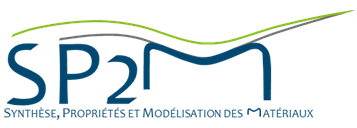
Comment passer d'un modèle énergétique complexe fondé sur la structure éléctronique d'un alliage à un modèle énergétique simple permettant d'en explorer la thermodynamique et d'en analyser les forces motrices ?
Une approche classique consiste à calculer les énergies associées aux interactions locales entre atomes plus proches voisins de structures ordonnées (Cluster Expansion Method). Ces énergies sont ensuite introduites dans des simulations de type Monte Carlo sur réseau. Il s'agit là d'une approche bottom-up : les données obtenues sur les structures basses températures sont utilisées pour décrire les structures hautes températures. Cette méthodologie est efficace mais elle ne permet pas d'extraire les effets chimiques des effets élastiques et ne décrit pas bien la solution solide aléatoire.
On développe une approche top-down qui consiste à décrire la solution solide aléatoire (structure haute température) pour étudier les structures basses températures. Partant d'un potentiel interatomique à N-corps, on détermine les énergies des atomes A et B de l'alliage AcB1-c selon leurs différents environnements locaux et selon la concentration nominale. Pour cela, on considère tous les environnements possibles en proches voisins d'un atome donné, le reste de la boîte étant dans des configurations chimiquement désordonnées de concentration fixée. Toutes les énergies sont obtenues après relaxation des positions atomiques. Nous avons développé un Hamiltonien fondé sur ces énergies de site, capable d'extraire les effets chimiques et élastiques même lorsque ces effets rentrent en compétition.
Effective site-energy model: A thermodynamic approach applied to size-mismatched alloys. F. Berthier, J. Creuze, B. Legrand, Physical Review B, 2017, 95, 224102
These studies are part of a vast framework that consists in characterizing the influence of the environment (mainly the atmosphere but one can also think of other factors: substrate, matrix in the case of nanoprecipitates or composite nanomaterials...) on the distribution of the constituants within nanoalloys. Indeed, if the particular physical properties of these objects are often obtained under vacuum conditions, the technological integration of these materials is subject to our ability to protect them from the ambient environment, in particular dioxygen, without loss of these properties. On the contrary, in the field of heterogeneous catalysis, the temperature and the partial pressures of the different gases are the key factors from the point of view of catalytic efficiency. Very often, the active state of the catalyst is reached only after an incubation time, from a few milliseconds to several days, the existence of such a time reflecting major changes within the catalyst. A simple example is the formation of a film close to the oxide on the surface of the catalyst in catalytic oxidation reactions. Finally, the surface segregation induced in metal alloys under reaction conditions, and thus the local variations in structure and composition, is a phenomenon that is predicted and observed for a certain number of bimetallic systems. Thus, while a certain configuration (structure, composition) may have the desired property, it is important to understand whether this particular configuration is stable in the environment of use for a specific application. One of the most standard examples is again probably the interaction between oxygen and metal surfaces, both from the (good) point of view of catalysis and the (bad) one of corrosion. Despite their importance, the details concerning the mechanisms involved in these phenomena are still very poorly understood.
Equilibrium Au-Pd(100) Surface Structures Under CO Pressure : Energetic Stabilities and Phase Diagrams. I. C. Oguz, T. Mineva, J. Creuze, H. Guesmi, The Journal of Physical Chemistry C, 2018, 122, 18922-18932
CO Adsorption-Induced Surface Segregation and Formation of Pd Chains on AuPd(100) Alloy: DFT-Based Ising Model and Monte Carlo Simulations. B. Zhu, J. Creuze, C. Mottet, B. Legrand, H. Guesmi, The Journal of Physical Chemistry C, 2016, 120, 350
Evidence of Pd segregation and stabilization at edges of AuPd nanoclusters in the presence of CO: a combined DFT and DRIFT study. B. Zhu, G. Thrimurthulu, L. Delannoy, C. Louis, C. Mottet, J. Creuze, B. Legrand, H. Gusemi, Journal of Catalysis, 2013, 308, 272
These studies concern heteroepitaxied metal deposits, i.e. metal A on a metal substrate B, which are generally characterized by the formation of surface superstructures and/or by self-organization phenomena for submonolayer coverages. The self-organization of nanoscale systems has been intensively studied in the last decades for their potential use in the manufacture of nano-objects with remarkable physical or catalytic properties. Among these self-organized systems, vicinal and/or faceted surfaces represent a promising route for producing nanostructured substrates. In this context and in collaboration with Yves Garreau (Materials and Quantum Phenomena (University Paris 7 / SOLEIL) and Alessandro Coati (SOLEIL), we are conducting a study on the evolution of the morphology of vicinal surfaces of copper and nickel induced by a silver deposit by coupling grazing incidence X-ray diffraction measurements on the one hand and scanning tunneling microscopy observations on the other hand with numerical simulations at the atomic scale. This coupling allows a better identification of the surface reconstructions and a better understanding of the driving forces of adsorbate-induced faceting.
Ag on a Ni vicinal surface: Coupling Stranski-Krastanov and “magic” heteroepitaxial growth. A. Bellec, Y. Garreau, J. Creuze, A. Vlad, F. Picca, M. Sauvage-Simkin, A. Coati, Physical Review B, 2017, 96, 085414
Incoherent Ag islands growth on Ni(100). J.-B. Marie, I. Braems, A. Bellec, C. Chacon, J. Creuze, Y. Girard, S. Gueddani, J. Lagoute, V. Repain, S. Rousset, Surface Science, 2017, 656, 101-108
AuNi alloy monolayer films electrodeposited on Au(111): An in situ STM study. F. Lecadre, F. Maroun, I. Braems, F. Berthier, C. Goyhenex, P. Allongue, Surface Science, 2013, 607, 25-32
Évolution temporelle d'un cuboctaèdre CuAg : à gauche configuration initiale désordonnée, au centre configuration métastable de structure oignon, à droite configuration stable de type cœur-coquille
Les nanoalliages peuvent apparaître dans des configurations très éloignées de celles d'équilibre. Ces configurations sont susceptibles d'évoluer vers les configurations d'équilibre. Pour étudier les cinétiques dans les nanoalliages, nous avons considéré un formalisme sur réseau, dont les paramètres ont été ajustés sur le système Cu-Ag. Deux types d'algorithme sont utilisés : l'un est stochastique (Monte Carlo Cinétique) et l'autre est déterministe, fondé sur le Champ Moyen Cinétique par site. Ces études sont menées en collaboration avec l'IRN Nanoalloys.
Ageing of out-of-equilibrium nanoalloys by a kinetic mean-field approach. F. Berthier, A. Tadjine, B. Legrand, Phys. Chem. Chem. Phys., 2015, 17, 28193-28199
This work concerns the study of the modifications of the thermodynamic behaviors of bimetallic nanoparticles according to their size and their morphology, in comparison with the observed behaviors in bulk and surface of the alloys (finite size effect on the phase diagrams). More generally, it aims at obtaining a detailed understanding of the driving forces of superficial segregation from the transposition of numerical simulations at the atomic scale (molecular dynamics or Monte Carlo simulations using N-body potentials or ab initio calculations) and models already developed in the context of semi-infinite alloys (mean-field or rigid lattice Monte Carlo methods including structure effects in an effective way). One of the key points lies in taking into account the coupling between atomic rearrangements, local (relaxations) or collective (structure change of the entire nanoparticle), and chemical (order, segregation, disorder), coupling which constitutes one of the difficulties inherent to the small size systems and which can drastically influence any of the above phenomena.
Direct measurement of the surface energy of bimetallic nanoparticles: Evidence of Vegard’s rule-like dependence. A. Chmielewski, J. Nelayah, H. Amara, J. Creuze, D. Alloyeau, G. Wang, C. Ricolleau, Physical Review Letters, 2018, 120, 025901
Magic compositions in Pd-Au nanoalloys. B. Zhu, A. Front, H. Guesmi, J. Creuze, B. Legrand, C. Mottet, Computational and Theoretical Chemistry, 2017, 1107, 49-56
Stability Diagram of Janus and Core–Shell Configurations in Bimetallic Nanowires. E. Maras, F. Berthier, B. Legrand, J. Phys. Chem. C, 2016, 120, 22670-22680
Crossover among structural motifs in Pd-Au nanoalloys. B. Zhu, H. Guesmi, J. Creuze, B. Legrand, C. Mottet, Physical Chemistry Chemical Physics, 2015, 17, 28129
Phase diagrams of nanoalloys: influence of size and morphology. F. Berthier, E. Maras, B. Legrand, Phys. Chem. Chem. Phys., 2015, 17, 28347-28353

